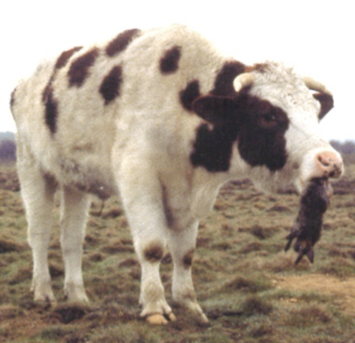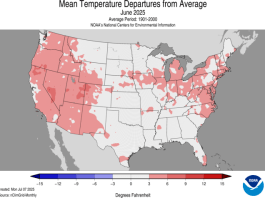 A team of researchers at the USDA Agricultural Research Service’s (ARS) Forage-Animal Production Research Unit has found that an antimicrobial compound in red clover can increase feed efficiency in ruminants. Biochanin A could be an alternative to using antibiotics to promote growth in feedlots, and could benefit livestock on pasture too.
A team of researchers at the USDA Agricultural Research Service’s (ARS) Forage-Animal Production Research Unit has found that an antimicrobial compound in red clover can increase feed efficiency in ruminants. Biochanin A could be an alternative to using antibiotics to promote growth in feedlots, and could benefit livestock on pasture too.
How Antibiotics and Antimicrobials Help Ruminants
Ruminant digestion is a process that relies on billions of bacteria and microorganisms. While beneficial bacteria break down fiber and turn forage into nutrients, there are some that “steal” protein and turn it into methane, excreted as gas, or ammonia, excreted in urine. Antibiotics suppress these “Hyper Ammonia-producing Bacteria” (HABs) so that the animal can absorb nutrients that otherwise would have been lost. That means that more of what the animal eats goes into producing meat and milk. And that’s why cattle have been fed antibiotics like tylosin, lasalocid and monensin.
 Using antibiotics to promote growth is being discouraged now because of concerns the practice could contribute to antibiotic resistance. So ARS microbiologist Michael Flythe and a team of researchers began to look for alternatives. They began to explore red clover as a “Functional Feed” to provide the same benefit as the antibiotics.
Using antibiotics to promote growth is being discouraged now because of concerns the practice could contribute to antibiotic resistance. So ARS microbiologist Michael Flythe and a team of researchers began to look for alternatives. They began to explore red clover as a “Functional Feed” to provide the same benefit as the antibiotics.
Testing Biochanin A
In the lab, biochanin A was tested on cultures of Hyper Ammonia-producing Bacteria (HAB), and then in rumen fluid from fistulated goats. In both cases biochanin A prevented the bacteria from growing.
But how would it work in the field? To find out, the researchers ran two feeding trials. They split 48 Angus cross steers into three groups. One group went to pasture, the second grazed pasture and was fed dry distiller’s grains, and the third grazed pastures and ate dry distiller’s grains with enough added biochanin A to equal what they would get if a third of their diet was red clover.
We know that grains will increase weight gains. In this case, lab tests showed that dry distiller’s grains also increase the number of HABs in the rumen. But when biochanin A was added to the dry distillers grain, the number of HABs decreased dramatically. And, as you can see, the biochanin A group had the biggest weight gains at about 2 pounds per day, compared to just over a pound and a half per day for the pasture only group.

So What Can You Do With This Information?
Adding red clover to your pastures could work well for you, especially if you’re raising young stock and steers. It can increase weight gain, and, like other legumes, it can fix nitrogen in your soil. But there are some cautions to consider. First, grazing lush clovers also raises the potential for bloat. Second, biochanin A is a phytoestrogen, meaning that it is chemically similar to estrogen, and has the potential to impact fertility.
Sheep seem to be most vulnerable. Studies show that a large amount in their diet (25% or more) can reduce ewe fertility and lambing rates. Studies have not shown effects on rams from grazing red clover. Tests with dairy cows in Wisconsin shows red clover in the diet shows improvement in feed efficiency and slightly suppressed milk production (1 -3 llbs/cow/day). Finally, studies on beef cows are not conclusive. One study showed impacts, another did not. So the Forage-Animal Production Research team will be running experiments with ram lambs and market cows in the future.
The team has done some additional research and found a really exciting benefit of red clover in endophyte infected tall fescue pastures. We’ll cover that in an upcoming issue.
Thanks to Michael Flythe for sharing the research papers and information for this article. The links below will take you to the abstracts.
Biochanin A improves fiber fermentation by cellulolytic bacteria





Thanks for following this research…please share on FB!
Never been a fan of DDG as I didn’t like the effect it had on the cow, her contentment and her manure over several days….still don’t consider it a good feedstuff and have a better understanding of the underlying cause now thanks to the paper.
We live in tough country for red clover…..at best a weak biannual but more often an annual in low density….recent variety releases seem no better than old standards. As long as RC seed price remains similar to crimson or vetch, we will continue use in winter annual blends.
Interested in similar research for white clover and hairy vetch.
Thanks,
Doug
I’ve top-seeded (frost seeded) both common double-cut and Freedom red clover in thin spots in alfalfa. The field also has a section that is too wet for alfalfa and grows almost straight timothy. Last summer both parts of the field were harvested early as haylage and made superb feed. The timothy was almost all leaf. Nevertheless, when time for feeding came, the cows eating a bale of grass, a tiny bit of alfalfa, and lots of red clover ate about 1/3 less. No very scientific, but my cows didn’t want to do replications.
Comments are closed.